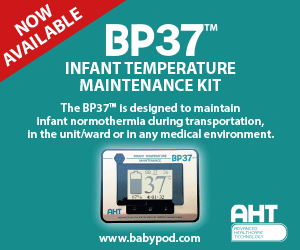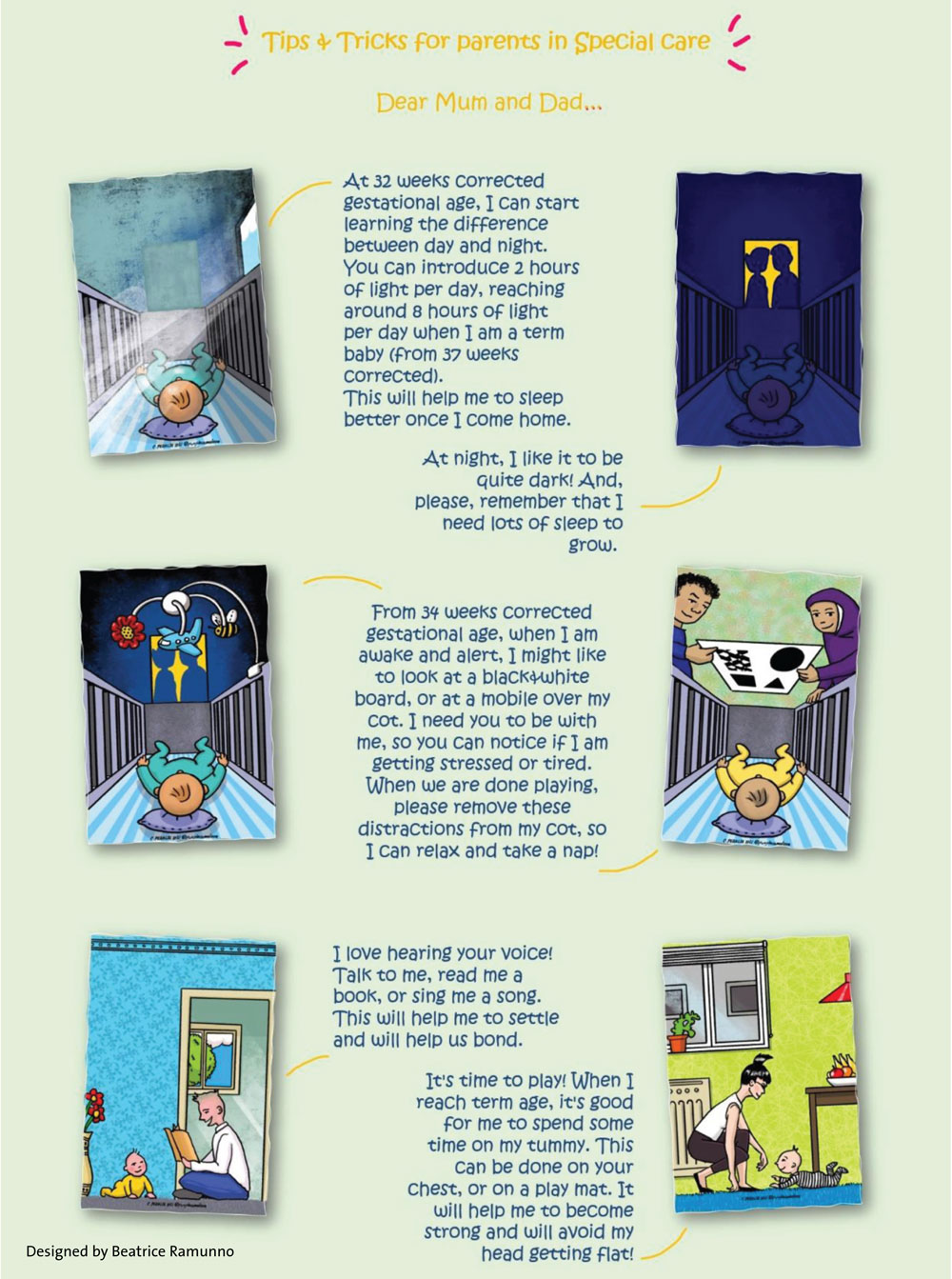Neurodevelopmental care: tips and tricks for parents in special care
Beatrice Ramunno
Neonatal Staff Nurse, Trevor Mann Baby Unit,
University Hospitals Sussex NHS Foundation Trust, Brighton
b.ramunno@nhs.net
While observing practice on the neonatal unit, I noticed that some aspects of developmental care, for instance kangaroo care, are widely praised and practised, while others are not so well known or employed quite as much.
As part of a work-based learning university module for special care/high dependency, I focused on four main topics concerning neurodevelopmental care to inform parents and nursing staff. As part of this work I produced an informative poster, which I share here with you. This was designed to benefit parents and staff and help with the choice of appropriate instruments to aid infants of different gestational ages to reach their neurodevelopment potential.
1. The cycled light approach
Preterm infants can start developing circadian behavioural rhythms at 30 weeks’ gestation – a dark-light cycle.1 The circadian system matures progressively after birth, requiring regular visual stimulation after 40 weeks’ gestation.2 While light does not appear to be essential for the early development of the fetus or preterm infant, a lack of sufficient light to be able to see during the critical period of visual development post-term, could be detrimental to vision.3
Most neonatal units have adopted the use of dimmed lights, within the range of 10-600 lux. However, changes in light due to treatment and procedures, do not consider the developing diurnal patterns of the infant.4 Infants may experience intense arousal effects from light and noise in the neonatal unit and may remain in transitional states with closed eyes, neither asleep nor available for social contact.4
Previous research has demonstrated that cycled lighting can be beneficial for the secretion of growth hormone and that the establishment of circadian patterns and post-natal weight gain among preterm infants are improved in neonatal units that employ the cycled light strategy.1
Following Family and Infant Neurodevelopmental Education (FINE) recommendations,5 the information poster advises the introduction of two hours of daylight per day starting at 32 weeks gestational age, progressing to reach eight hours at term equivalent age and aiming for darkness at night.
2. Auditory stimulation
Auditory learning begins in utero.3 The noisy environment of the neonatal unit can be detrimental to the development of the auditory system2 and infants in a neonatal unit are relatively deprived of the maternal voice and stimuli for early language learning, which may affect communication skills later in life.6 A study found that infants receiving an increased amount of parent talk during their hospital stay had higher language and cognitive scores at seven- and 18-months corrected age.4
While some parents perceive talking, singing or reading to their infant as an intervention that they can easily and happily carry out, others may find it difficult to talk to their child in the neonatal unit environment,8 or may find talking through the incubator walls pointless and lacking intimacy.6 The poster aims to encourage parents to engage in ‘conversation’, singing or reading to their infant to help establish a bond between parent and child.
3. Visual stimulation
Infants born prematurely have an increased risk of visual deficit and visual processing problems, due to the incomplete formation of eye structures and the environment of the neonatal unit (eg lights too bright/dark, lack of visual stimulation), which can affect the development of both the eye and the central nervous system.3 A newborn’s colour vision is limited and generally in greyscale.9 From around 34 weeks corrected gestational age, infants are able to fix their gaze. Research found that infants are responsive to high contrast visual patterns; typically, black and white patterns elicit more fixation compared to low contrast patterns.10-12 Furthermore, a complex stimulus will have a sensitising effect on the infant’s looking behaviour, alluding to basic processing skills that correlate to later cognitive performance.12
The poster encourages the adoption of visual stimuli in the form of black and white boards or a cot mobile for the awake and alert infant, being mindful of their behavioural cues to avoid over-stimulation. It also reminds parents to remove such distractions from their child’s cot space, as they may find it difficult to break their gaze.
4. Tummy time
By the time a preterm infant reaches term-equivalent age, it has a strong flexor tone, resistance and ability to make smooth movements. At this stage of development, prone positioning of the infant facilitates actions such as lifting the head and weight-shifting across the shoulders and pelvic muscles, which will eventually lead to independent sitting, crawling and manipulation of objects. Supporting positional and movement development will contribute to locomotor, spatial, cognitive and social development.13
An unintended consequence of the ‘Back to Sleep’ campaign to prevent sudden infant death syndrome (SIDS), has led to a reduction in the practice of tummy time. Research reports infants obtain less than 30-60 minutes of tummy time, the recommended time to prevent positional plagiocephaly.14,15 A lack of prone experience can result in late achievement of developmental milestones and contribute to skull and facial asymmetry.13
With regards to tummy time, the poster aims to encourage parents to independently position their infant and participate in tummy time activities. Access to stimulating objects and parental attention will increase the infant’s tolerance of the position to help improve muscular strength.15
Yours sincerely
Beatrice Ramunno
The information poster designed by Beatrice Ramunno for neurodevelopmental care in the neonatal unit. Illustrations kindly provided by Carlos Peralta (Instagram @purplecamaleonpics).
Or read this article in our
Tablet/iPad edition



